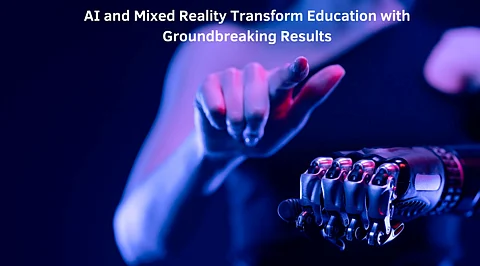

Transposing the digital world at lightning-fast speed, AI-enhanced reality redesigns the world of education by developing thrilling interactive learning environments. Based on analysis by Suresh Vakkalanka, this next generation technology involves merging artificial intelligence in mixed reality that enables person-centered experiences and learning to happen in real time. This would make complex concepts more accessible and attractive, thus transforming education and elevating the fruits of learning in ways that would lead to a more vibrant and effective experience in education.
The integration of artificial intelligence with mixed reality technologies marks a pivotal shift in educational methods, offering personalized and immersive learning experiences that were previously impossible. The research demonstrates a remarkable 27% increase in conceptual understanding across STEM subjects compared to traditional teaching methods, with overall student engagement rising by 42%.
AI-embellished mixed reality has displayed exceptional performance for retaining knowledge; there was 72.4% retention of learned materials six months down the line while, in a typical learning environment, just 41.8% were retained. The virtual laboratories prove particularly effective as they improve conceptual understanding by 42% while ensuring that the otherwise hazardous materials used for experiments can be dealt with without causing harm.
This is a significant step forward in the educational technology effectiveness profile as AI-based personalization can analyze data at various points including interaction patterns, learning pace, and performance metrics to create all-rounded learner profiles. These adaptive approaches show an improvement in learning outcomes to 28 percent in comparison to the standardized methods; besides, with an accuracy rate of 83 percent, one can predict students' performance in advance.
The technology has transformed static content into dynamic, interactive learning experiences. There is a proved retention of 31% more information when traditional texts are enhanced by 3D models and interactive simulations. Use of 3D visualization tools has been shown to be effective in subjects that require spatial understanding like molecular biology and architectural design.
Economic regions have quite a difference in AI adoption as shown by research. The most developed economies, in this case, high-income economies, lead with an expected 78% of AI implementation by 2025. Middle-income economies aim at a lesser, 45% AI adoption rate.
Mobile applications of mixed reality are growing with an impressive rate of 74%, which in turn is enabling advanced learning technologies to reach various student populations. According to research, hybrid learning platforms have reached an impressive implementation rate of 82%, pointing towards the trend of blended education. These patterns show that the technology environment in education keeps on changing, but at the same time, evidence still exists indicating the presence of the digital divide between economic regions.
The technology emphasizes an improvement of over 39.7% on complex systems understanding and of over 34.2% on abstract concept understanding. Strengths in 21st-century skills have also marked improvement; the percentages for digital literacy enhanced by 42.3% and collaborative capabilities enhanced by 37.8%.
The education institutions embrace the latest infrastructural innovations. For this situation, the bare minimum requirements include bandwidth of 100 Mbps per 50 concurrent users and low latency of less than 15 ms for optimum performance. With such scalability and cost-effectiveness, as much as 89 percent of AI solutions in cloud-based apps have been adopted.
Implementation: The solution includes robust security features like a minimum of AES-256 encryption requirement and multi-factor authentication at all entry points. Data protection frameworks ensure privacy for students through five minimum layers of protection and the strict retention policy of personal data at 18 months maximum.
International cooperation in educational technology has gained high heights: 45 countries participating in cutting-edge research. This platform connects 178 institutions all over the world for the purposes of knowledge sharing and innovative solution. A very substantial amount, namely €125M invested in research funding proves a global interest in understanding the role of technology in education better and improving this role. In fact, it forms a strong base for the spread of best practices in the realm of technological integration into learning environments across the globe.
The research concludes with the findings of successful implementation for technical infrastructure adaptation, pedagogical adaptation and privacy concerns. Initial start-up costs have been reported ranging from $75,000 to 120,000 per 100 students. As far as cost-benefit justifications of expenditure are concerned over educational outcomes or operational efficiency; it seems right.
These technologies suggest more and more advanced capabilities in personalization and adaptive learning while also demanding continued research in learning analytics and implementation methodologies. This remains an endeavor toward making more inclusive, effective, and engaging learning environments with fewer accessibility and equity challenges.
In conclusion, the analysis by Suresh Vakkalanka reveals that AI-enhanced mixed reality is, indeed, a revolutionary improvement in educational technology for bringing a transformative pedagogy approach in teaching and learning. In short, this revolutionary integration promises an exciting future toward more engaging, effective, and inclusive education.
